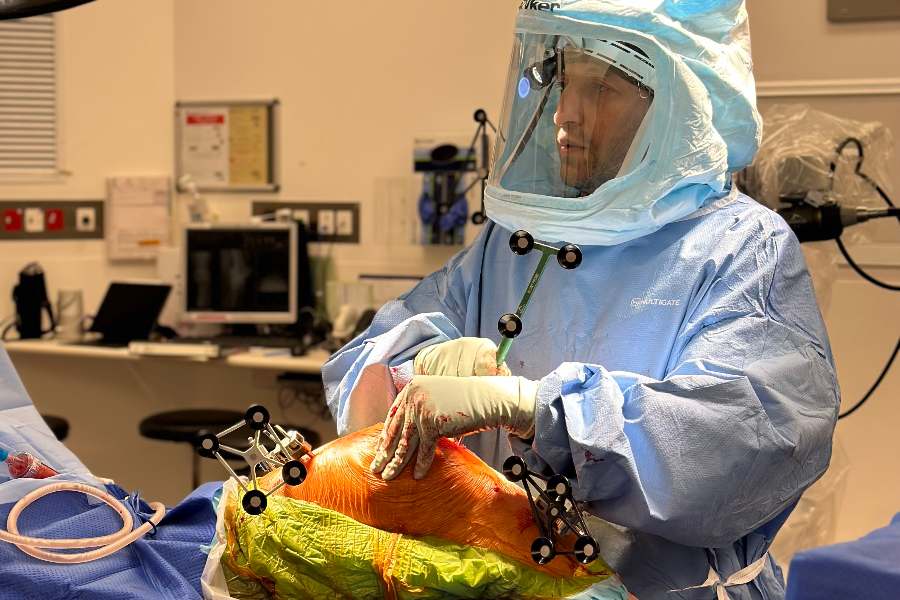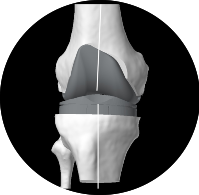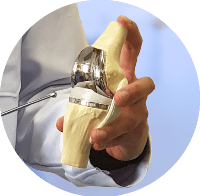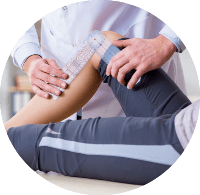ROBOT-ASSISTED
TOTAL KNEE REPLACEMENT PERTH
Patient overview:
Robotic Knee Replacement Surgery –
Explanation, advantages, pain management, rehabilitation & risks.
Australian Academy of Robotic
Orthopaedic Surgeons
Robot-Assisted Knee Replacement Specialists
Robotic Total Knee Replacement Surgery
The information presented is for educational purposes only. Individual results vary. Speak to your doctor about the surgical advantages and risks to decide if robotic joint replacement surgery is right for you.
*To view all references and statistics visit – Stryker.
What is Total Knee Replacement Surgery
Total knee replacement surgery is a medical procedure in which the worn out or damaged surfaces of the knee joint are removed and replaced with artificial components, called a prothesis. The prothesis may be made from a range of materials such as stainless steel, titanium, ceramics and medical grade polyethylene.
The goal of knee replacement surgery is to relieve pain and restore function in the diseased or damaged knee joint/s.
The surgery involves cutting away damaged bone and cartilage from your thighbone (Femur), shinbone (Tibia) and kneecap (Patella) and replacing it with the prosthesis.
Your doctor may choose from a variety of knee replacement prostheses and surgical techniques, considering your age, weight, activity level, knee size and shape, overall health and individual goals and circumstances.

What is Robot-Assisted Total Knee Replacement Surgery?
Advantages of Robot-Assisted Knee Replacement Surgery
The MAKO Technology and Robotic-Arm allows for:
*MAKO Robot-Assisted technology research data
Mako data shows it has a lower revision rate than the same components implanted using any other knee replacement technique.
Evidence also exists to show patients undergoing MAKO Robot-Assisted Total Knee Replacement commonly have:
Pain Management
After Robot-Assisted Total Knee Replacement Surgery
In recent years Anaesthetists who specialise in pain management and control have substantially improved pain management in relation to Total Knee Replacement surgeries.
There have been major advancements in multi-modal pain management techniques that substantially reduce the pain discomfort from surgery and post-operative recovery. When combined with the post-operative data of MAKO Robot-Assisted Total Knee Replacement technology patients may experience less pain and require less post-operative pain medication as a result in less soft tissue ‘cutting’ which translates to less pain.
Patients may still experience some mild discomfort. Most patients are generally encouraged to stand and walk within hours of surgery. Please report your pain levels and discomfort to the nursing staff.
A pain management plan will be discussed with you in depth before and after your operation to ensure you are comfortable throughout your recovery and rehabilitation.
Robotic Knee Replacement Perth – Rehabilitation
Rehabilitation is a major element in determining a successful outcome of Total Knee Replacement Surgery. Rehabilitation is driven by physiotherapist professionals and the hard work and dedication of the patient to get back to normal activities as fast as possible. The rehabilitation process starts the day of the surgery and is an ongoing process for at least 6 months.
The rehabilitation program may help with:
Your knee rehabilitation program will be discussed in depth with your surgeon and physiotherapist and designed to meet your specific needs and concerns.
Risks and Complications
As with any major surgery, there are potential risks involved. The decision to proceed with the surgery is made because the advantages of surgery outweigh the potential disadvantages. It is important that you are informed of these risks before the surgery takes place.
Complications can be medical (general) or local complications specific to the Knee. Medical complications include those of the anaesthetic and your general well being. Almost any medical condition can occur so this list is not complete.
Complications may include:
Serious medical problems can lead to ongoing health concerns, prolonged hospitalisation or rarely death.







